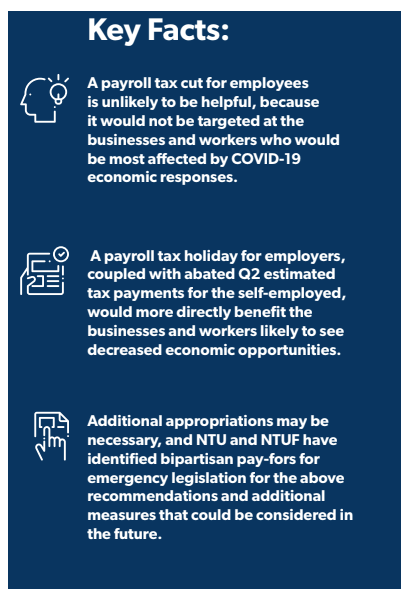 Former White House Chief of Staff Rahm Emanuel once said that you should “never let a good crisis go to waste,” and in traditional Washington, D.C.-style policymakers are releasing a panoply of ideas, such as large infrastructure and climate packages, hoping that their pet project can hitch a ride on any bill that would help blunt the economic impacts of the COVID-19 virus. These sorts of responses are dubious even during the largest of economic downturns, but the current crisis is different because it is first, and foremost, a public health crisis rather than an ordinary economic contraction.
Former White House Chief of Staff Rahm Emanuel once said that you should “never let a good crisis go to waste,” and in traditional Washington, D.C.-style policymakers are releasing a panoply of ideas, such as large infrastructure and climate packages, hoping that their pet project can hitch a ride on any bill that would help blunt the economic impacts of the COVID-19 virus. These sorts of responses are dubious even during the largest of economic downturns, but the current crisis is different because it is first, and foremost, a public health crisis rather than an ordinary economic contraction.
Officials are urging “social distancing” and remote work to help limit the spread of the disease, particularly over time. The more dramatic scenarios of potential simultaneous infections would stretch the U.S. public health infrastructure as high-risk individuals increase the demand for intensive care. By spreading the infections over time, hospitals and healthcare workers stand a chance to ensure the safety of Americans.
But that social distancing can cause economic hardships. As individuals stay home and work remotely and children stay home from school, these individuals—at the urging of public health officials—are decreasing their spending on leisure, such as restaurants, hotels, travel, movie theaters, and bowling alleys. This is unlike a traditional economic downturn where discretionary spending falls due to perceived or real financial constraints.
This means a payroll tax cut, gaining steam in Washington as the preferred COVID-19 response policy, is unlikely to be helpful. Cutting an individual’s payroll tax liability doesn’t change the decisionmaking framework in this context because the constraints they face are not primarily financial, they are social. Regardless of ability or desire to go see a movie or enjoy time at a bowling alley, Americans are being told to stay home, avoid crowds, and not to travel. Additionally, payroll tax cuts don’t benefit those who are retired and not working since they don’t have wage income, when age is among the biggest risk factors for COVID-19.
Instead, the largest economic concern is with owners of and workers for businesses that people aren’t visiting as frequently; restaurants, tourist destinations, hotels, airlines, and so on. Businesses like these may see a sudden decrease in revenue, which could then create the kind of financial constraint that typically fuels economic downturns. Our concern should be focused on these businesses and workers as they struggle to make payroll and cover rent during what is hopefully a short economic downturn.
Policymakers should work collaboratively with banks and lending institutions to ensure that affected businesses have financial flexibility on their debt obligations, such as providing flexibility on loan payment due dates. The federal government could go so far as to facilitate short-term borrowing and expanded capital access. The administration has made progress on capital access, but more work is needed.
There are tax policy ideas that could be impactful, however. A payroll tax holiday for employers could also make sense in balancing short-term liquidity issues. The tax holiday would also reduce any incentive to lay off workers temporarily. The tax code should mitigate current tax rules on net operating losses, allowing businesses to fully use their net operating losses for the 2020 tax year. A similar policy could be constructed for the self-employed, in the form of abating Quarter 2 estimated tax payments and providing guidance on penalty waivers for those needing to pay Quarter 1 taxes late (for which payments are due April 15). Both actions could be helpful to households where a worker faces reduced hours (and pay) and one or more members of the household must pick up additional self-employment opportunities to make ends meet. Eliminating tariffs, which have increased costs on goods for American households and businesses by tens of billions of dollars, would be a smart solution too.
Additionally, policymakers should consider ways to facilitate employers allowing their affected workers to take adequate time off. While many white-collar workers have access to remote work, fewer hourly workers have the same options. Finding a way to encourage sick employees to stay home without jeopardizing their financial situation is a worthwhile cause.
The Federal Reserve provided policymakers with a runway, cutting interest rates by 50 basis points last week, and it is expected to cut rates in its meeting next week.
Finally, it’s important to note that a more traditional spending package was just approved last week, providing an additional $8 billion in funding to fight the disease. It is possible further appropriations will be necessary, which is why it is important that policymakers provide certainty on the protocols necessary to prevent the spread of the virus. Bond market volatility has driven down federal borrowing rates, which reduces the expense to taxpayers of financing such spending but policymakers should ensure any emergency appropriations do not become part of the permanent budget baseline.
Congress should also work to find adequate spending offsets, such as reducing wasteful and duplicative spending elsewhere in the budget, to shield taxpayers from additional burdens. NTU and NTUF have a long history of identifying unnecessary spending that should surely fall lower on the priority list than responding to the developing COVID-19 situation.
These policies themselves aren’t perfect, but these are much better suited to the current economic times than large infrastructure packages or a wasteful aggregation of everyone’s pet projects.

